
Dendrelaphis bifrenalis, also called Boulenger's bronzeback, Boulenger's bronze-back, and Travancore bronze-brown snake, is a colubrid snake native to Eastern Ghats of Southern India and Sri Lanka. It was first described by George Albert Boulenger in 1890. Dendrelaphis wickrorum from Sri Lanka was previously confused with this species.

Dendrelaphis cyanochloris, commonly known as Wall's bronzeback or the blue bronzeback, is a species of snake found in Southeast Asia.
Dendrelaphis biloreatus is a species of tree snake in the family Colubridae. The species is endemic to Asia.

Dendrelaphis humayuni, also known commonly as the Nicobar bronzeback or Tiwari's bronzeback, is a species of snake in the family Colubridae. The species is endemic to the Nicobar Islands of India.
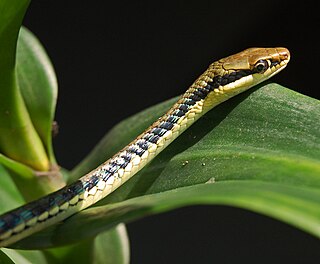
Dendrelaphis pictus is a species of snake found in Southeast Asia and India.
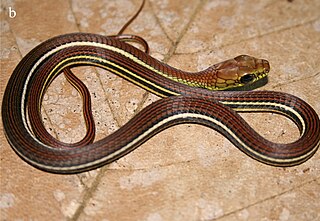
Dendrelaphis caudolineatus is a common species of colubrid snake known commonly as the striped bronzeback or grey bronzeback. It is not venomous and it is the most commonly sold snake as a pet; however, they live longer in the wild.

Dendrelaphis is a genus of colubrid snakes, distributed from Pakistan, India and southern China to Indonesia, Timor-Leste, the Philippines, Australia, New Guinea and the Solomon Islands. There are over forty described species. Asian species are known commonly as bronzebacks, while the Australo-Papuan species are simply called treesnakes. All are non-venomous and entirely harmless to humans.

Dendrelaphis punctulatus, also known commonly as the Australian tree snake, the common tree snake, and the green tree snake, is a species of slender, large-eyed, diurnal, non-venomous snake in the family Colubridae. The species is native to many parts of Australia, especially in the northern and eastern coastal areas, and to Papua New Guinea.

The yellow-capped pygmy parrot is a species of parrot in the family Psittacidae mainly found throughout western New Guinea. Its natural habitats are subtropical or tropical moist lowland forest, subtropical or tropical mangrove forests, and subtropical or tropical moist montane forest. Like many parrots, this pygmy parrot is affectionate to its mate. It is currently unknown if they remain monogamous for life like many bigger parrots because of their isolated location, which is difficult to reach.
The Kei goby is a species of goby native to marine and brackish waters along the coasts of Mozambique, South Africa, Madagascar and the Seychelles. This species can reach a length of 7 centimetres (2.8 in) TL.

Ashok Captain is an Indian herpetologist who has authored books and papers on Indian snakes. He was also a competing cyclist from 1977 to 1989.
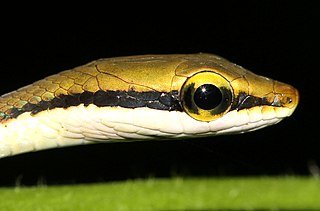
Dendrelaphis girii, Giri's bronzeback tree snake or Giri's bronzeback, is a species of diurnal, arboreal, Colubrid snake endemic to the Western Ghats of southwestern India.
Dendrelaphis oliveri, commonly known as Oliver's bronzeback, is a species of nonvenomous arboreal snake in the family Colubridae. The species is endemic to Sri Lanka. It is considered to be the rarest of the Sri Lankan Dendrelaphis species on account of there being only a single recorded specimen.

Dendrelaphis nigroserratus is a species of snakes belonging to the bronzebacks (Dendrelaphis). It is found only in western and southwestern Thailand and the adjacent southeastern Myanmar. A specimen has been preserved in the British Natural History Museum, London since the early 20th century. Due to its resemblance to Wall's bronzeback, the scientific name was formerly assigned under Dendrelaphis cyanochloris, the species name for Wall's bronzeback. It was formally described as a distinct species in 2012 by Gernot Vogel, Johan Van Rooijen and Sjon Hauser. According to the World Wide Fund for Nature report, it became one of the 367 important new species discovered in the Greater Mekong during 2012 and 2013.
Paraperipatus keiensis is a species of velvet worm in the Peripatopsidae family. This species is green-black with yellow-brown spots. Females of this species have 24 or 25 pairs of legs; males have 22 or 23. Females range from 27 mm to 48 mm in length, whereas males range from 25 mm to 33 mm. The type locality is in Kai Besar, Indonesia.

The Ahaetuliinae are a subfamily of the snake family Colubridae that was erected in 2016 and comprises five genera containing 63 species that are more closely related to one another than to members of the subfamily Colubrinae. Previously placed within Colubrinae, Ahaetuliinae was strongly supported as the sister group to Colubrinae in a 2016 study by Figueroa et al.
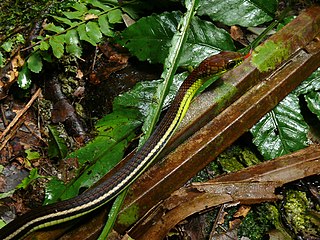
Dendrelaphis formosus, also known as the elegant bronzeback, is a snake species in the family Colubridae.
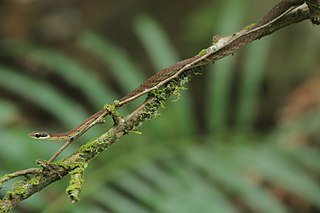
Dendrelaphis caudolineolatus, commonly known as Gunther's bronzeback tree snake, is a species of snake of the family Colubridae.

Dendrelaphis andamanensis, the Andaman bronzeback, is a species of snake in the family Colubridae. The species is found on the Andaman Islands in India.
Dendrelaphis grismeri is a species of snake in the family Colubridae. The species is found in Indonesia.














